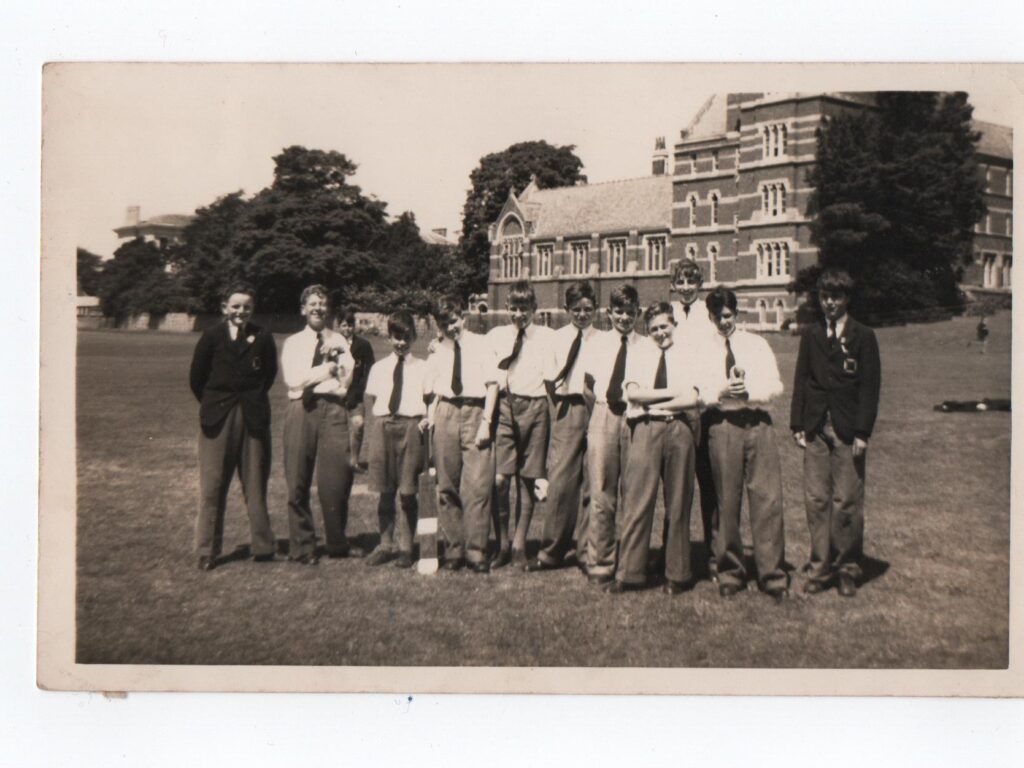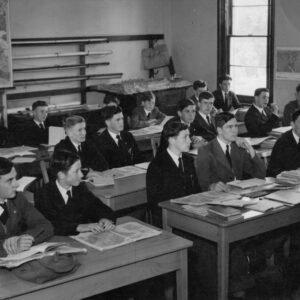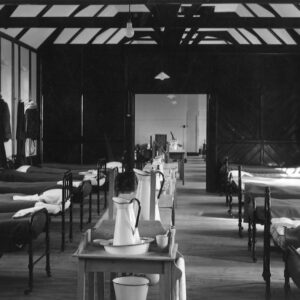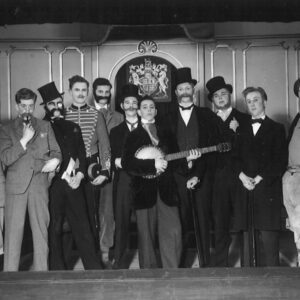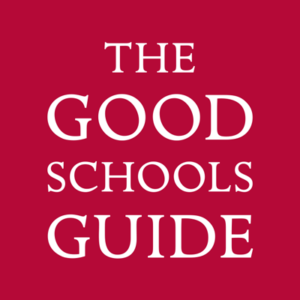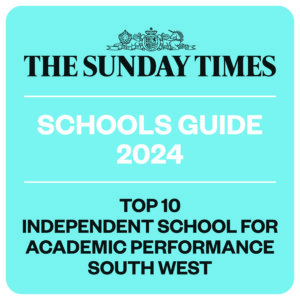Jon Lewis (1954-1962)

Francis Kinnier Paul had been headmaster for four years. The school accounts on his arrival were in deficit. By 1954 he had succeeded in balancing the books, but we were still encouraged to write on both sides of the paper. No formal programme of austerity was imposed upon us, but there was no extravagance. All of us had been born during the war, so that was how it was.
It was an all-boys school of course, as were, it seems, all schools of the same sort in the Southwest. There were around 375 of us in the main school in 1954, to increase to over 450 by the end of the decade. A ‘School List’ was issued every year, listing all the boys in each form with their Form Master, all the boys in each house with their House Master, and at the end a formidable alphabetic list of all the boys in the school with their addresses and dates of birth. It must have been an enormous job to put this together in the days before computers or word-processing equipment. This was obviously long before Privacy laws were invented or needed.
For the winter and spring terms we wore grey trousers – shorts for the first two years – and jackets with white shirts and black ties. In the summer term a blue blazer instead of the grey jacket. Out of school everyone wore a school cap except prefects.
School lunches were in two sittings. They were probably simple enough, but we were used to that. The one memorable item was the ‘stodge’ – treacle or jam or currant or just plain with custard. In much demand for seconds. The two-sittings arrangement made for a long lunch hour. In the winter terms we played ‘one kick’ scoring different points for converting a place kick, a drop goal or a punt over the rugby posts, negated if the other side caught it. Didn’t do much for the white shirts.
What we did not do was play football. We were a rugby school. If ‘Fred’ (Francis Kinnear Paul, 1950-1960), as our Headmaster was irreverently known by staff and students alike, detected any contravention to his no-football rule, he would descend from his office in person and stride across the playing field, gown billowing, to arrest the miscreants.

From Monday to Friday we had seven lessons a day, four in the morning and three in the afternoon, except for I think two afternoons when we had games.
There was also school on Saturday mornings, and in the winter term we had to stay at school on Saturday afternoons to support the First XV. Fred would stroll up and down the Lower Drive, and the support would rise and fall depending on where he had reached in his perambulations.
One or two of the weekly lessons was PT. The school gymnasium was at the time the biggest hall in the school. Every morning began with chapel. The chapel was not quite big enough to take all the school, so each day in rotation one house stayed out and had ‘house prayers’ instead under its House Master. In those days all schoolrooms were within audible reach of the chapel bell. Boys in the Middle Fifth, teams of two changing each week, had the job of ringing it to mark the beginning or end of lessons.
Sometimes the headmaster wanted or needed to speak to the school after chapel, in the gymnasium if raining, or from the chapel steps if fine. Once someone in School House who was supposed to be off sick took a picture of such a chapel-step address, which found its way into the hands of his House Master, John Marsden. Years later John told me he had finally found a suitable caption for it, from a piece in the Daily Telegraph deploring the lack of training given to apprentice plumbers. The heading for the article was ‘Watch Fred is the only way to learn’.

One joined the CCF in the Lower Fifth. Perhaps this is still the case. The CCF was something to which the Headmaster, who held the TD and had reached the rank of Lieutenant Colonel in the war, attached enormous importance. No one ever ‘got off’ Corps. If you came to Exeter School, you joined the CCF. The whole contingent must have been over three hundred, parading on Fridays. Many of our schoolmasters had served in the war, and a number of these re-donned their uniforms to bring their experience to the CCF. It was a very well-run operation led by the unique and memorable Colonel Lionel Barker. Once a term there was a Field Day, sometimes also a night exercise, often on Woodbury Common.
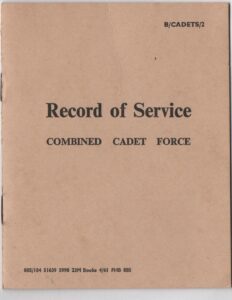
Sport was a fundamental part of school life, the importance of the playing field, one often felt, was not far behind that of the classroom in the school’s priorities. The school calendar, issued every term, was dominated with the sports programme, rugby only in the winter term, hockey and cross country in the spring term, cricket and athletics, and later tennis, in the summer term. For each of the three main sports there were First, Second and Third teams, and normally three ‘Colts’ teams, under 16, Under 15 and Under 14; one could be playing for the school at the age of thirteen. For the best players of all sports colours were awarded, at the discretion of the relevant captain and master-in-charge. For these envied few a colours badge replaced the standard maltese cross on their blazer pocket, and they were able to wear striped ties, a different one for each sport. Other than these, only prefects and members of the Crossing Club were able to wear ties different from the standard black.
Evidence of diversifying interests at Exeter School during the 1950s is shown by the growth in the number of Clubs and Societies. In 1954 there were only six, one of which was the Crossing Club, the Sixth Form debating society which I was delighted to hear is still with us. The others were the Music Club, the Geographical Society, the Natural History Society, the Christian Fellowship and the Young Farmers Club. By 1960 the number had grown to fourteen; one could now also join Clubs or Societies covering a wider range of subjects; Art, History, Models, Transport, Sailing, Drama and Stamp Collecting. The Chess Club also made its first reported appearance in 1955, but since it played competitive matches against other schools, was considered as something approaching a sports activity.
The Drama Club went from strength to strength putting on plays, including I remember Twelfth Night, but had no direct involvement in the series of Gilbert and Sullivan Operas directed by John Marsden and Ivan Cole, performances of a high-quality including Pirates of Penzance, Iolanthe and Patience, and involving large casts. The female parts were played by younger boys with treble voices.
Clubs and Societies used to meet after school on Tuesdays. Each had a Chairman, Secretary and Treasurer, elected by the members, overlooked by a Master-in-Charge.
Once a term member of the Clubs and Societies went on ‘Outings Days’, each to their separate interests, the Natural History Society for example searching for fossils at Lyme Regis or visiting Paignton Zoo, the Young Farmers visiting a sheep farm or a bacon factory, the Transport Society exploring the engine sheds at St David’s.
In the mid-1950s there were seven houses, in order of foundation, School House (for the boarders), Drake, Raleigh, Buller, Crossing, Daw and Goff.
The seven Housemasters ranked high in the school hierarchy. These appointed for each year a Head of House, usually the house’s senior prefect. Heads of House had fairly wide-ranging responsibilities including selecting the captains for the various house sports during the year and assigning duties to other members of the house for the term and year. These included – remote as the idea now seems – the receipt and distribution of milk, still provided by the government until the mid-sixties. Milk was consumed by house in the morning break, an informal moment for members of the house to get together.
Another was house prayers once a week when the House Master chose somebody new each week to read the lesson.
Each house was around sixty strong, and with only about ten new boys arriving each year the House Masters and Heads of House could get to know their charges very well. Indeed, the composition of the house was known to all its members, and older members would provide younger members with been-there-done-that counselling as they faced new challenges moving up the school.
The expression of house identity took its most visual form in the annual house matches. This was serious stuff; house matches were bitterly contested. For the three major sports a knock-out system was employed, with the winner of last year’s tournament getting a ‘bye’ into the second round. There were also inter-house cross country, athletics and ‘standards’ competitions. Each house normally had one or two top sportsmen, but house matches also gave the opportunity to those who were not part of any school team, or not yet old enough, to participate on behalf of one’s house, all of whose members would turn out to cheer them on.
At the end of the year the Inter-House Shield was awarded. This was closely contested and was based on a points system bringing in all aspects of school life, not just academic and sporting.
The main purpose of Exeter School then as now was to exploit the intellectual potential of each student to its maximum. But the wide range of other available activitites ensured a culture of full involvement, commitment, and responsibility. We were kept very busy.


